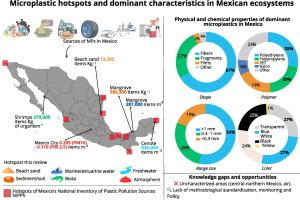墨西哥微塑料污染现状:综述与发展展望
IF 8
1区 环境科学与生态学
Q1 ENVIRONMENTAL SCIENCES
引用次数: 0
摘要
微塑料污染已成为一个重大的全球环境问题。这些源自大型塑料降解的小塑料碎片渗入海洋和陆地生态系统。本文综述了墨西哥使用PRISMA方法研究微塑料的现状。收集的信息集中在微塑料在不同环境基质中的分布、特征和丰度。从2014年到2024年,在高质量的数据库中进行了文献检索,得出了80篇科学论文,记录了墨西哥20个州的沉积物/土壤、生物群、水和大气等环境基质的研究。最广泛研究的环境基质是沉积物,特别是海滩砂,其次是生物群、水和大气。报道最多的微塑料形状和颜色是透明和蓝色纤维,主要由聚丙烯和聚乙烯制成。规范微塑料的研究方法,作为评估和比较国内和全球微塑料丰度的监测工具是势在必行的。取样、实验室分析和丰度报告单位的标准化将促进研究的比较。建立一个国家微塑料数据库将支持长期监测并为缓解战略提供信息。这一举措符合可持续发展目标14——水下生命——具体目标14.1.1。b为了减少海洋污染,淡水、土壤和空气中普遍存在微塑料,这凸显出需要将可持续发展目标6、可持续发展目标12和可持续发展目标15结合起来,从整体上解决塑料污染问题。本文章由计算机程序翻译,如有差异,请以英文原文为准。

The state of microplastic pollution in México: a review and evolving perspectives
Microplastic pollution has emerged as a significant global environmental concern. These small plastic fragments, originating from the degradation of larger plastics, infiltrate marine and terrestrial ecosystems. This article reviews the current state of research on microplastics in Mexico using the PRISMA method. The information collected focused on the distribution, characterization and abundances of microplastics across different environmental matrices. A literature search was conducted in high-quality databases from 2014 to 2024, resulting in 80 scientific articles documenting studies in environmental matrices such as sediments/soil, biota, water and atmosphere across 20 states of Mexico. The most extensively studied environmental matrix is sediment -particularly beach sand-, followed by biota, water and atmosphere. The most reported microplastic shapes and color are transparent and blue fibers, primarily made of polypropylene and polyethylene. It is imperative to standardize the methods for studying microplastics to serve as a monitoring tool for assessing and comparing microplastic abundances both nationally and globally. The standardization of sampling, laboratory analysis, and abundance reporting units will facilitate the comparison of studies. Establishing a national microplastics database would support long term monitoring and inform mitigation strategies. While this initiative aligns with Sustainable Development Goal 14 -Life Below Water- specifically target 14.1.1.b aimed at reducing marine pollution, the widespread presence of microplastics in freshwater, soil and air underscores the need to integrate SDGs 6, SDG 12 and SDG 15 to address plastic pollution holistically.
求助全文
通过发布文献求助,成功后即可免费获取论文全文。
去求助
来源期刊

Science of the Total Environment
环境科学-环境科学
CiteScore
17.60
自引率
10.20%
发文量
8726
审稿时长
2.4 months
期刊介绍:
The Science of the Total Environment is an international journal dedicated to scientific research on the environment and its interaction with humanity. It covers a wide range of disciplines and seeks to publish innovative, hypothesis-driven, and impactful research that explores the entire environment, including the atmosphere, lithosphere, hydrosphere, biosphere, and anthroposphere.
The journal's updated Aims & Scope emphasizes the importance of interdisciplinary environmental research with broad impact. Priority is given to studies that advance fundamental understanding and explore the interconnectedness of multiple environmental spheres. Field studies are preferred, while laboratory experiments must demonstrate significant methodological advancements or mechanistic insights with direct relevance to the environment.
 求助内容:
求助内容: 应助结果提醒方式:
应助结果提醒方式:


